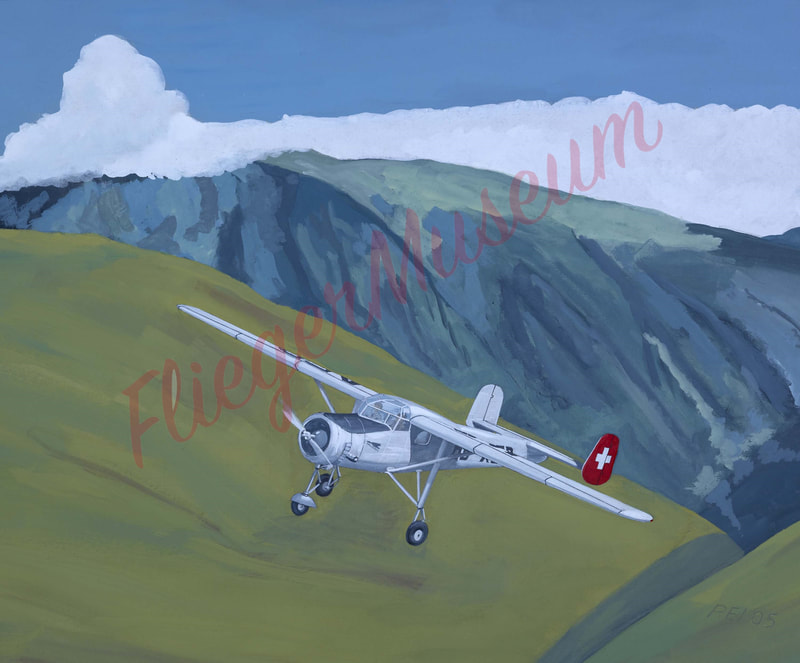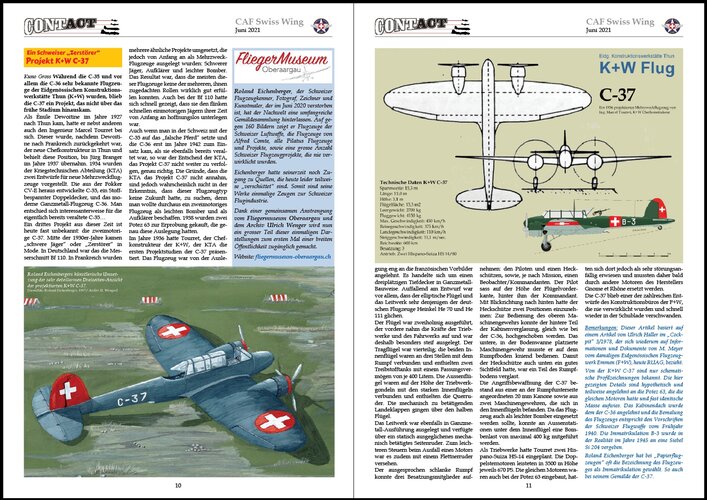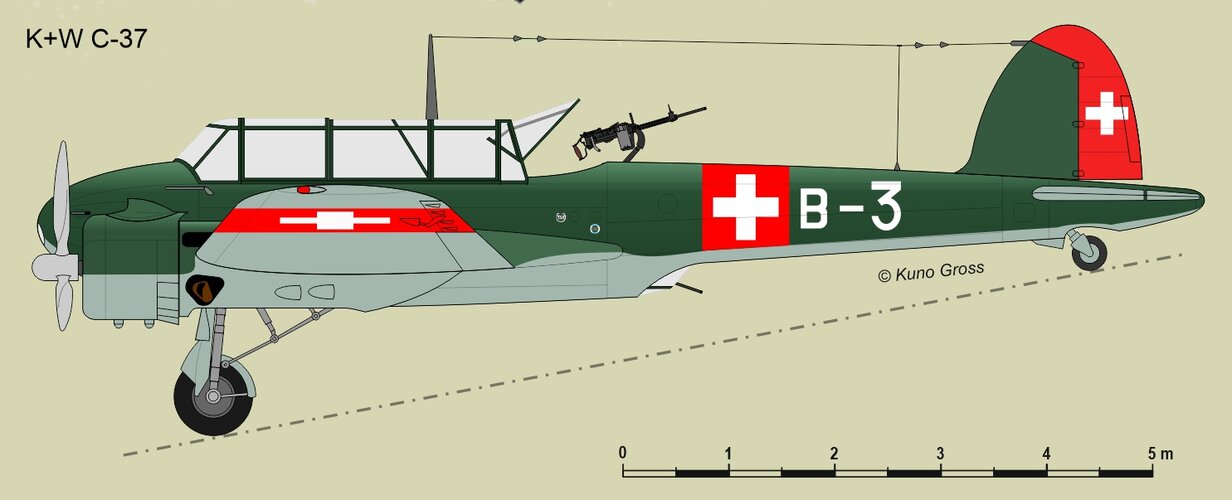The C-35 and the C-36 are well known, actually built, aircraft of "Eidgenössische Konstruktionswerkstätte" in Thun. The planned C-37 is rather less known. Last year I had the chance to re-work an 1978-article of "Cockpit" and I was lucky to get to see a painting of Roland Eichenberger - combining this information I was able to draw a sideview of the C-37 (taking some "artistic license):
You are using an out of date browser. It may not display this or other websites correctly.
You should upgrade or use an alternative browser.
You should upgrade or use an alternative browser.
K+W C-37
- Thread starter Kuno
- Start date
[Kuno Gross] While the C-35 and especially the C-36 became very well-known aircraft of the Eidgenössische Konstruktionswerkstätte Thun (K+W), the C-37 remained a project that did not get beyond the early stage.
When Èmile Dewoitine came to Thun in 1927, he had with him, among others, the engineer Marcel Tourret. The latter became the new chief designer in Thun after Dewoitine returned to France and retained this position until Jürg Branger took over in 1937. In 1934, two designs for new multi-role aircraft were presented to the War Technical Department (KTA). The C-35, a fabric-covered biplane developed from the Fokker CV-E, and the modern all-metal C-36 aircraft. Interestingly enough, the decision was made in favour of the C-35, which was actually already obsolete...
A third project from this period is almost unknown today: the twin-engined C-37. In the mid-1930s, "heavy fighters" or "destroyers" came into fashion. In Germany, this was the Messerschmitt Bf 110. In France, several similar projects were implemented, but they were designed as multi-role aircraft from the beginning: Heavy fighter, reconnaissance plane and light bomber. The result was that most of these aircraft could not really fulfil any of the multiple roles assigned to them very well. Even with the Bf 110, it quickly became apparent that it was hopelessly inferior to the nimble fast single-engine fighters of its time from the very beginning.
Even though Switzerland bet on the "wrong horse" with the C-35 and the C-36 did not enter service until 1942, when it too was already obsolete, the KTA's decision not to pursue the C-37 project was exactly right. The reasons why the KTA did not accept the C-37 project, however, were probably not the realisation that this type of aircraft had no future, because they certainly wanted to procure a twin-engined aircraft as a light bomber and as a reconnaissance aircraft. In 1938, two Potez 63s were purchased for testing, which had exactly this design.
In 1936, Tourret, the chief designer of K+W, had presented the first project studies of the C-37 to the KTA. The design of the aircraft was closely based on the French prototypes. It was a three-seat low-wing monoplane in all-metal construction. The most striking feature of the design was that the elliptical wing and the tail unit were very similar to those of the German Heinkel He 70 and He 111 aircraft.
The wing was of two-spar design, the front one took the forces of the engines and the landing gear and was therefore particularly stiff. The wing was four-piece; the two inner wings were connected to the fuselage at three points and contained two fuel tanks, each with a capacity of 400 litres. The outer wings were connected to the strong inner wings at the level of the engine nacelles and contained the ailerons. The mechanically operated landing flaps went over half the wing.
The tail unit was also of all-metal design and had a statically balanced mechanically operated rudder. It was also equipped with a Flettner rudder for easier steering in case of engine failure.
The extremely slim fuselage could accommodate three crew members: the pilot and a tail gunner, plus, depending on the mission, an observer/commander. The pilot sat at wing leading edge level, with the commander behind him. Facing the rear, the tail gunner had to take up two positions: To operate the upper machine gun, the rear part of the cabin glazing could be pushed up, the same as on the C-36. The lower machine gun, placed in the floor pan, had to be operated while kneeling on the fuselage floor. So that the rear gunner also had a good field of vision below, part of the fuselage floor was glazed.
The C-37's attack armament consisted of a 20 mm cannon mounted on the underside of the fuselage and two machine guns mounted in the inner wings. Since the aircraft was also to be used as a light bomber, a maximum bomb load of 400 kg could be carried at outboard stations under the inner wing.
Tourret had planned two Hispano-Suiza HS-14 engines. The twin star engines produced 670 hp each at 3500 m altitude. The same engines had also been installed in the Potez 63, but had proved to be very susceptible to failure there and therefore soon had to be replaced by other engines from the manufacturer Gnome et Rhône.
The C-37 remained one of the numerous designs of the F+W design office that were never realised and quickly disappeared in the drawer again.
Remarks: This article is based on an article by Ulrich Haller in "Cockpit" 3/1978, which in turn refers to information and documents by M. Meyer of the then Eidgenössisches Flugzeugwerk Emmen (F+W), today RUAG.
Only schematic profile drawings of the K+W C-37 are known. The details shown here are hypothetical and partly based on the Potez 63, which had the same engines and almost identical dimensions. The canopy was based on that of the C-36 and the painting of the aircraft corresponds to the regulations of the Swiss Air Force of spring 1940. In reality, the registration B-3 was given to a Siebel Si 204 in 1945.
Roland Eichenberger often chose the designation of the aircraft as the registration for "paper aircraft". This is also the case with his painting of the C-37.
When Èmile Dewoitine came to Thun in 1927, he had with him, among others, the engineer Marcel Tourret. The latter became the new chief designer in Thun after Dewoitine returned to France and retained this position until Jürg Branger took over in 1937. In 1934, two designs for new multi-role aircraft were presented to the War Technical Department (KTA). The C-35, a fabric-covered biplane developed from the Fokker CV-E, and the modern all-metal C-36 aircraft. Interestingly enough, the decision was made in favour of the C-35, which was actually already obsolete...
A third project from this period is almost unknown today: the twin-engined C-37. In the mid-1930s, "heavy fighters" or "destroyers" came into fashion. In Germany, this was the Messerschmitt Bf 110. In France, several similar projects were implemented, but they were designed as multi-role aircraft from the beginning: Heavy fighter, reconnaissance plane and light bomber. The result was that most of these aircraft could not really fulfil any of the multiple roles assigned to them very well. Even with the Bf 110, it quickly became apparent that it was hopelessly inferior to the nimble fast single-engine fighters of its time from the very beginning.
Even though Switzerland bet on the "wrong horse" with the C-35 and the C-36 did not enter service until 1942, when it too was already obsolete, the KTA's decision not to pursue the C-37 project was exactly right. The reasons why the KTA did not accept the C-37 project, however, were probably not the realisation that this type of aircraft had no future, because they certainly wanted to procure a twin-engined aircraft as a light bomber and as a reconnaissance aircraft. In 1938, two Potez 63s were purchased for testing, which had exactly this design.
In 1936, Tourret, the chief designer of K+W, had presented the first project studies of the C-37 to the KTA. The design of the aircraft was closely based on the French prototypes. It was a three-seat low-wing monoplane in all-metal construction. The most striking feature of the design was that the elliptical wing and the tail unit were very similar to those of the German Heinkel He 70 and He 111 aircraft.
The wing was of two-spar design, the front one took the forces of the engines and the landing gear and was therefore particularly stiff. The wing was four-piece; the two inner wings were connected to the fuselage at three points and contained two fuel tanks, each with a capacity of 400 litres. The outer wings were connected to the strong inner wings at the level of the engine nacelles and contained the ailerons. The mechanically operated landing flaps went over half the wing.
The tail unit was also of all-metal design and had a statically balanced mechanically operated rudder. It was also equipped with a Flettner rudder for easier steering in case of engine failure.
The extremely slim fuselage could accommodate three crew members: the pilot and a tail gunner, plus, depending on the mission, an observer/commander. The pilot sat at wing leading edge level, with the commander behind him. Facing the rear, the tail gunner had to take up two positions: To operate the upper machine gun, the rear part of the cabin glazing could be pushed up, the same as on the C-36. The lower machine gun, placed in the floor pan, had to be operated while kneeling on the fuselage floor. So that the rear gunner also had a good field of vision below, part of the fuselage floor was glazed.
The C-37's attack armament consisted of a 20 mm cannon mounted on the underside of the fuselage and two machine guns mounted in the inner wings. Since the aircraft was also to be used as a light bomber, a maximum bomb load of 400 kg could be carried at outboard stations under the inner wing.
Tourret had planned two Hispano-Suiza HS-14 engines. The twin star engines produced 670 hp each at 3500 m altitude. The same engines had also been installed in the Potez 63, but had proved to be very susceptible to failure there and therefore soon had to be replaced by other engines from the manufacturer Gnome et Rhône.
The C-37 remained one of the numerous designs of the F+W design office that were never realised and quickly disappeared in the drawer again.
Remarks: This article is based on an article by Ulrich Haller in "Cockpit" 3/1978, which in turn refers to information and documents by M. Meyer of the then Eidgenössisches Flugzeugwerk Emmen (F+W), today RUAG.
Only schematic profile drawings of the K+W C-37 are known. The details shown here are hypothetical and partly based on the Potez 63, which had the same engines and almost identical dimensions. The canopy was based on that of the C-36 and the painting of the aircraft corresponds to the regulations of the Swiss Air Force of spring 1940. In reality, the registration B-3 was given to a Siebel Si 204 in 1945.
Roland Eichenberger often chose the designation of the aircraft as the registration for "paper aircraft". This is also the case with his painting of the C-37.
Roland Eichenberger, the Swiss aircraft connoisseur, photographer, draughtsman and painter, who died in June 2020, left an extensive collection of paintings to posterity. In around 160 pictures, he shows aircraft of the Swiss Air Force, the aircraft of Alfred Comte, all Pilatus aircraft and projects, as well as a large number of Swiss aircraft projects that were never realised.
At the time, Eichenberger still had access to sources that have unfortunately been partially "buried" today. Thus his works are unique witnesses to the Swiss aviation industry.
Thanks to a joint effort by the Fliegermuseum Oberaargau and the Ulrich Wenger archive, a large part of these unique representations is now being made accessible to the general public for the first time.
Website: fliegermuseum-oberaargau.ch
At the time, Eichenberger still had access to sources that have unfortunately been partially "buried" today. Thus his works are unique witnesses to the Swiss aviation industry.
Thanks to a joint effort by the Fliegermuseum Oberaargau and the Ulrich Wenger archive, a large part of these unique representations is now being made accessible to the general public for the first time.
Website: fliegermuseum-oberaargau.ch
Indeed - he made many paintings, and as I understood from him, he even met the people who were in charge for these projects, had access to the drawings... but apparently he dind not keep copies of these drawings...The last sentence of this very interesting article, sounds very seductive a and gives hope for more!
- Joined
- 25 July 2007
- Messages
- 3,873
- Reaction score
- 3,179

Fliegermuseum Oberaargau
Die gesamte Sammlung kann in Bleinbach besichtigt werden. Eine hochauflösende Kopie kann auf Anfrage ausgedruckt werden.
www.fliegermuseum-oberaargau.ch
- Joined
- 26 May 2006
- Messages
- 32,689
- Reaction score
- 11,918
Brilliant,many thanks to you my dear Kuno,
and we hope to get more about this company,and we know EKW became EFW,and
for unknown reason,EKW which began its series from DH-1 up to M-8,then the next
entry was C-35,why ?.
and we hope to get more about this company,and we know EKW became EFW,and
for unknown reason,EKW which began its series from DH-1 up to M-8,then the next
entry was C-35,why ?.
- Joined
- 25 July 2007
- Messages
- 3,873
- Reaction score
- 3,179
... for unknown reason,EKW which began its series from DH-1 up to M-8,then the next entry was C-35,why ?.
hesham, this has been explained before ...
-- https://www.secretprojects.co.uk/threads/projects-in-switzerland.8232/page-3#post-539141
C-35 was a Swiss military designation. Earlier K+W/EKW styles were for internal, corporate designations.
DH = Doppeldecker Häfeli (Biplane Häfeli) with parallel 'M' (for Militär) designations.
MA = Militär-Apparat (Military Machine); August Häfeli designs beginning with MA-6 .
Similar threads
-
Early Swiss aircraft rockets? (Pre 8 cm Oerlikon)
- Started by blockhaj
- Replies: 27
-
-
-
-


